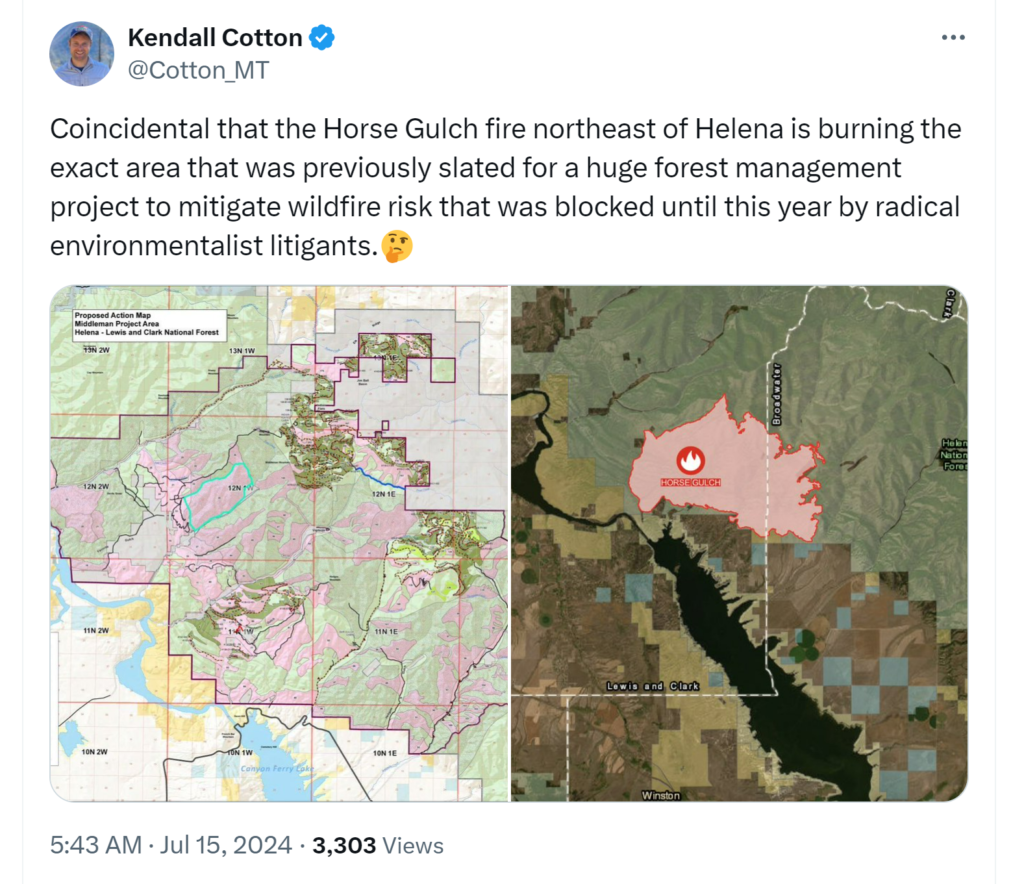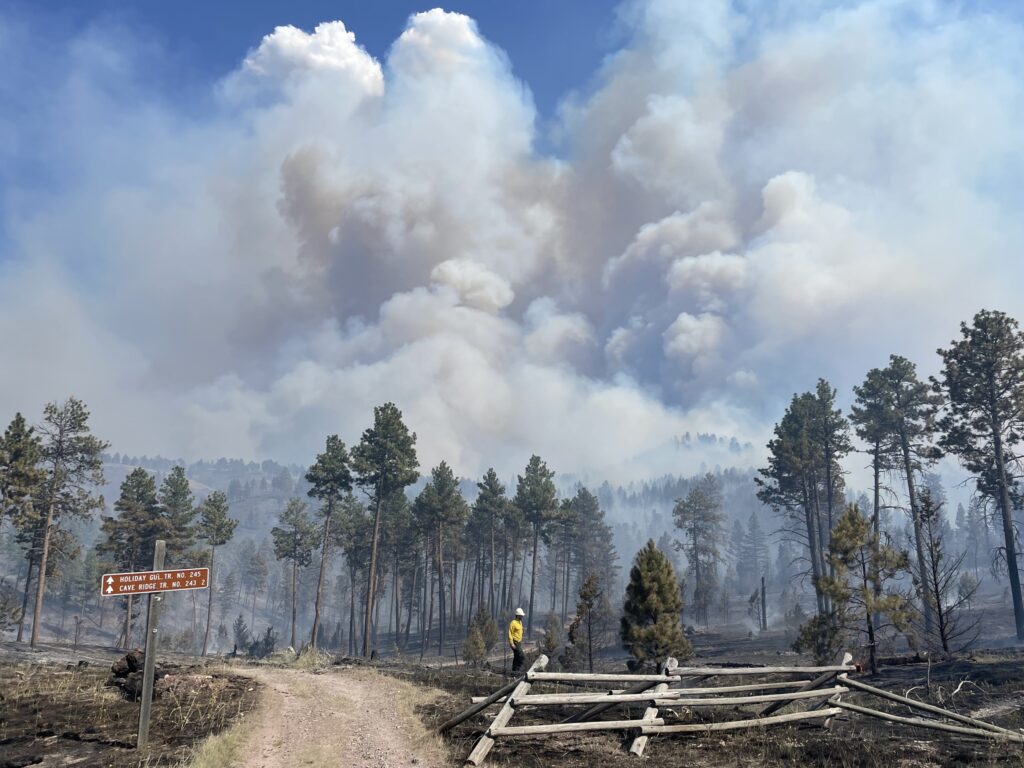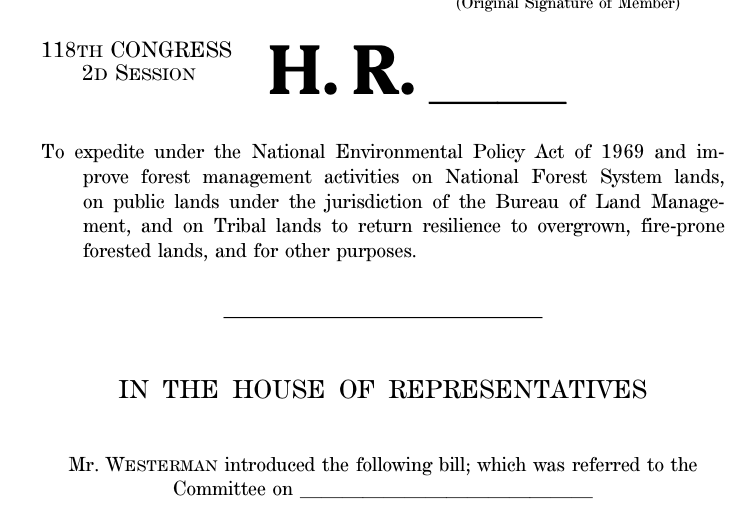I was asked to take a look at the Fix our Forests Act, which just passed the House, from the NEPA perspective. Last week, I was on an NGO webinar in which the general feeling was that none of the NEPA provisions would last in the Senate. However, it appears that some deals were made in the House, as 55 Democrats supported it. I will leave it as a student exercise to map exactly what Districts those 55 represent. Now the news stories say that the President is, or perhaps more accurately, some members of the Administration who have been designated to speak for it on this issue, are against it. I did go off on a bit of an R&D tangent in this section, so there will be two sequential posts.
Let’s take a look at the bill ourselves, then we’ll look at the media coverage.
The Firesheds;
The bill would designate some areas as high-risk firesheds. These would include firesheds already identified in the Wildfire Crisis Strategy plus:
(B) shall be comprised of individual landscape-scale firesheds identified by the Secretary, in consultation with the Secretary of the Interior, as being in the top 20 percent of the 7,688 firesheds published by the Rocky Mountain Research Station of the Forest Service in 2019 for wildfire exposure based on the following criteria—
(i) wildfire exposure and corresponding risk to communities, including risk to structures and life;
(ii) wildfire exposure and corresponding risk to municipal watersheds, including tribal water supplies and systems; and
(iii) risk of forest conversion due to wildfire;
My take: for years, GAO has wanted to use models instead of political gimmees and/or random agency “give some to everyone” to distribute hazardous fuels bucks, so this seems like it might be useful.
Designation of these fireshed management areas, in and of itself, is not a NEPA decision; nice to be specific about that.
Fireshed Center
Yes, I know this came from the Wildfire Commission, and I know many people I respect worked hard on that. Nevertheless, it looks to me as if wildfires and fuel treatments are being managed fairly well by the FS, BLM, States, Tribes (and less so by FEMA). It looks to me like 1) other agencies sense big money and want to get in on it and 2) an opportunity for an interagency clusterf as in “too many cooks spoil the broth.” The only thing many of these agencies have in common is… not being involved in wildfire heretofore. Unfortunately I can’t remember why all these agencies were represented on the Wildfire Commission, but given they were, I suspect that they want seats at the table when the funding is handed out, and/or to reframe wildfire as being about them.. climate, national security, and so on.
The Directors of the Center are Forest Service, and instead of BLM, USGS. Now what could go wrong when a research agency is running something operational? I remember when R&D was taken from Interior agencies in the guise of efficiency. As I recall, it had a negative impact on the ability of “doing” agencies to get the research they felt they needed. Recently we had the example of NIH (a research agency) taking over from CDC (public health agency) on Covid response. I think that many of us following that issue remember that it did not go well. People in research organizations can have greater loyalty to funding their fave scientists than to the public interest.
Now, I am definitely a fan of coordination across agencies! I would like it if a USGS/FS team reviewed all proposals among their own folks, NSF, NIFA, NASA, and so on that are related to forests. Nevertheless, we are clearly making a reseach pool where field folks and their needs are not centered as they are often with FS R&D. Let’s face it, NSF NOAA and NASA have zillions of bucks already and are sharks in the pool, while the Joint Fire Sciences Program and FS R&D are minnows. Yes, “science” has politics imbedded in it.
Of course, as I recall there were only a few folks with wildland fire experience on the Commission, Kelly Martin and Neil Chapman. Interesting, now that I think about it, that no folks from the Union were on the Commission.
Let’s just do a thought experiment.. round up the same agencies for coordination but as oversight instead have a committee of wildland firefighters, FS researchers, and IMT folks including representation from States. That would subject research and tech development dollars to coordination, but with a clear filter of utility. I am generally concerned with the idea that the climate-military industrial-AI efforts will make wildland fire decisions even more opaque than they already.
Don’t worry little community, we have National Security eyes on everything you do so we can “protect you from wildfire”; oh, and we are giving that info to favored NGOs. Oh, and our drones operate off AI which is smarter than real human beings with experience, which we have displaced. After all, we’ve perfected our technology killing people. You have to trust that we know what’s best for you.
**************
Fireshed Registry
A publicly accessible website should provide a variety of useful information and be updated and folks can use it for CWPPs. Yes.
Shared Stewardship
With Tribes. Yes.
Fireshed Assessment
Seems useful, especially to communities, who may not understand if the FS has a POD plan or not, and should also deal with the prioritization of treatment question and make that more accessible and comprehensible to the public. And the local government gets to participate so this should tie nicely with local efforts with CWPPs and evacuation planning.
Emergency Fireshed Management Projects
2) FIRESHED MANAGEMENT PROJECTS.—The responsible official shall carry out the following forest and vegetation management activities as fireshed management projects under this section:
(A) Conducting hazardous fuels management activities.
(B) Creating fuel breaks and fire breaks.
(C) Removing hazard trees, dead trees, dying trees, or trees at risk of dying, as determined by the responsible official.
(D) Developing, approving, or conducting routine maintenance under a vegetation management, facility inspection, and operation and maintenance plan submitted under section 512(c)(1) of the Federal Land Policy and Management Act of 1976 (43 U.S.C. 1772(c)(1)).
(E) Removing trees to address overstocking or crowding in a forest stand, consistent with the appropriate basal area of the forest stand as determined by the responsible official.
(F) Using chemical or re-seeding and planting treatments to address insects and disease and control vegetation competition or invasive species.
(G) Any activities recommended by an applicable fireshed assessment carried out under section 105.
(H) Any activities recommended by an applicable community wildfire protection plan.
(I) Any combination of activities described in this paragraph.
It seems like the bill uses existing categorical exclusions:
(i) IN GENERAL.—Fireshed management projects carried out under this section shall be considered authorized projects under the following categorical exclusions:
(I) Section 603(a) of the Healthy Forests Restoration Act of 2003 (16 U.S.C. 6591b(a)).
(II) Section 605(a) of the Healthy Forests Restoration Act of 2003 (16 U.S.C. 6591d(a)).
(III) Section 606(b) of the Healthy Forests Restoration Act of 2003 (16 U.S.C. 6591e(b)).
(IV) Section 40806(b) of the Infrastructure Investment and Jobs Act (16 U.S.C. 6592b(b)).
(V) Section 4(c)(4) of the Lake Tahoe Restoration Act (Public Law 106–506; 114 Stat. 2353).
(VI) Subject to subsection (d) of section 40807 of the Infrastructure Investment and Jobs Act (16 U.S.C. 6592c) in the same manner as authorized emergency actions (as defined in subsection (a) of such section) are subject to such subsection.
(ii) USE OF EXPEDITED AUTHORITIES.—In carrying out a fireshed management project, the Secretary shall apply a categorical exclusion under clause (i)—
(I) in a manner consistent with the statute establishing such categorical exclusion; and
(II) in any area—
(aa) designated as suitable for timber production within the applicable forest plan; or
(bb) where timber harvest activities are not prohibited.
So here’s the kicker. The bill expands the existing CEs to 10K acres. from 3000 or 4500. It also changes the Lake Tahoe legislative CE
Here’s the original text of the Lake Tahoe CE
(4) AVAILABILITY OF CATEGORICAL EXCLUSION FOR CERTAIN FOREST MANAGEMENT PROJECTS.—A forest management activity conducted in the Lake Tahoe Basin Management Unit for the purpose of reducing forest fuels is categorically excluded from the requirements of the National Environmental Policy Act of 1969 (42 U.S.C. 4321 et seq.) if the forest management activity—
(A) notwithstanding section 423 of the Department of the Interior, Environment, and Related Agencies Appropriations Act, 2009 (division E of Public Law 111–8; 123 Stat. 748), does not exceed 10,000 acres, including not more than 3,000 acres of mechanical thinning;
(B) is developed—
(i) in coordination with impacted parties, specifically including representatives of local governments, such as county supervisors or county commissioners; and
(ii) in consultation with other interested parties; and
(C) is consistent with the Lake Tahoe Basin Management Unit land and resource management plan.
Fix our Forests would amend that to:
3) LAKE TAHOE RESTORATION ACT AMENDMENTS.—Section 4(c)(4)(C) of the Lake Tahoe Restoration Act (Public Law 106–506; 114 Stat. 2353) is amended—
(A) by striking “Lake Tahoe Basin Management Unit”; and
(B) by inserting “applicable to the area” before the period at the end.
This is puzzling because the project still has to be conducted in the LBTMU, so why wouldn’t it be consistent with the LTBMU? Someone out there must understand this.
If we look at the text of the LBTMU legislation, we could wonder why wouldn’t that CE apply to other areas, with perhaps lower economics and fewer high profile politicians? Is that environmental justice or climate justice? You don’t get your fuel treatments as easily as Lake Tahoe folks, because…
.. on to Fix our Forests II




